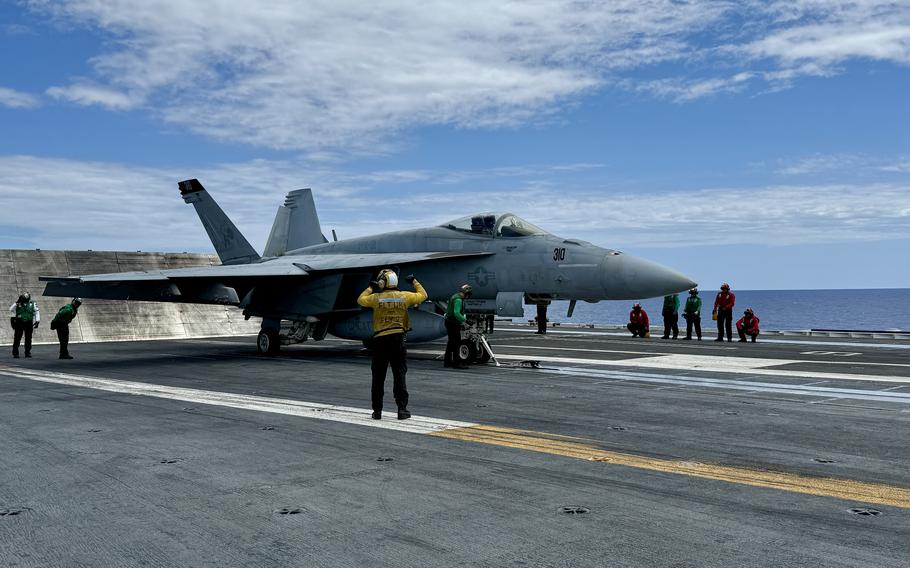
Sailors aboard the aircraft carrier USS Gerald R. Ford ready an F/A-18 Super Hornet for takeoff in the Ionian Sea on July 29, 2025. The Gerald R. Ford Carrier Strike Group is deployed to the U.S. 6th Fleet area of operations. (Alison Bath/Stars and Stripes)
ABOARD THE USS GERALD R. FORD — The Navy’s newest carrier strike group is putting hard-earned lessons from the Red Sea into practice, drawing on the fleet’s recent combat experience to shape its current Mediterranean deployment.
Before deploying, Carrier Strike Group 12 leaders had one-on-one meetings with commanders from the aircraft carrier Harry S. Truman, whose strike group battled Houthi militants and launched the largest carrier-based airstrike in history against Islamic State targets in Somalia.
The idea was to learn “what they experienced ... and how we can apply those lessons to our own deployment if we’re faced with the same kind of threat,” Rear Adm. Paul Lanzilotta, commander of Carrier Strike Group 12, told reporters Tuesday aboard USS Gerald. R. Ford in the Ionian Sea.
While the Ford strike group is currently operating in the Mediterranean, it’s not clear whether the carrier and its escorts will remain in the region or shift to the Middle East, where tensions continue to simmer.
Iran-backed Houthi militants have threatened to renew attacks on commercial shipping in the Red Sea, and the war in Ukraine shows no signs of ending. Ford’s presence serves as both a show of force and a hedge against escalation.
“I’m actually here to help manage that escalation so that it doesn’t start to go that way,” Lanzilotta said.
The U.S. has frequently kept an aircraft carrier or amphibious ready group in the Mediterranean Sea following Russia’s invasion of Ukraine in February 2022.
In January 2024, Ford ended a more than eight-month deployment to the U.S. 6th Fleet area of operations that included duty in the Eastern Mediterranean following Hamas’ attack on Israel in October 2023.
Then-Defense Secretary Lloyd Austin extended Ford’s deployment as the U.S. used a dual-carrier strategy as part of efforts to keep Hezbollah and other Iran-backed proxies from broadening the conflict.
The aircraft carrier USS Dwight D. Eisenhower, which was presumed to relieve Ford, was sent to the Middle East as part of that strategy. More recently, the Navy stationed five destroyers in the Eastern Mediterranean in June to defend Israel against Iranian attacks and promote regional stability.
Earlier this month, the Ford strike group entered the Mediterranean.
One of the most notable changes on this deployment is the role of the destroyer USS Winston Churchill, which is functioning as the air and missile defense commander for the strike group.
That role has long been filled by a cruiser. But with the Navy’s aging cruiser fleet nearing retirement, destroyers are bridging the gap. Churchill is the first East Coast destroyer equipped with the modifications to deploy to take on the role, officials said.
The shift in structure and training comes as the Navy reassesses how carriers may be targeted in combat.
In March, Adm. Daryl Caudle, commander of U.S. Fleet Forces, said Ford was training to use its close-in weapons system to defend against incoming missiles or drones, Naval News reported at the time.
Carriers in recent decades typically have been defended by embarked aircraft and escort ships.
But in March 2024, officials aboard the USS Dwight D. Eisenhower on duty in the Red Sea acknowledged that the Houthis had employed swarm drone attacks and upgraded ballistic missile capabilities.
Since its arrival, the Ford group has trained with the Spanish and Italian navies and participated in Neptune Strike 25-2, a NATO exercise spanning multiple theaters, including the Mediterranean, the Baltic Sea, Eastern Europe and the Black Sea.
The exercise emphasizes long-range air operations, according to NATO.
On Tuesday, there were about 90 to 100 flights scheduled aboard Ford, officials said, noting that four catapults and three arresting wires that help launch and stop aircraft, respectively, had been in use on the carrier during the entire deployment.
“We are fully mission-capable to meet all missions at any time at any place,” said Capt. David Skarosi, commander of USS Gerald R. Ford.
Leaders say sailors have aggressively trained for this deployment, which marks the third to the U.S. 6th Fleet area of operations for the carrier.
The group’s day-to-day operations focus on training and readiness for any contingency, such as challenging weather conditions or the need to provide humanitarian assistance.
“Or, if there’s some crisis in the region, we’re able to respond to that, too,” Lanzilotta said.